Value-Added-Based Accounting of CO2 Emissions: A Multi-Regional Input-Output Approach
Abstract
1. Introduction
2. Materials and Methods
2.1 Direct Carbon Emission Factor
2.2 Value-Added Based Accounting of CO2 Emissions
2.3 Data Source
3. Results
3.1 Gross VBEs and Gross PBEs
3.2 Full CO2 Emissions Intensity and Direct CO2 Emissions Intensity
3.3 CO2 Embodied in Value Added Chains
4. Discussion
5. Conclusions
Acknowledgments
Author Contributions
Conflicts of Interest
Abbreviations
| CBE | Consumption-Based accounting of CO2 Emissions |
| CDIAC | Carbon Dioxide Information Analysis Center |
| COP | Global Conference of Parties |
| DCI | Direct Carbon emissions Intensity |
| EKC | Environmental Kuznets Curve |
| FCI | Full Carbon emissions Intensity |
| GDP | Gross Domestic Production |
| GHG | Greenhouse Gas |
| IOT | Input-Output Table |
| MRIO | Multi-Regional Input-Output table |
| OECD | Organization for Economic Cooperation and Development |
| PBE | Production-Based accounting of CO2 Emissions |
| PPP | Purchasing Power Parity |
| ROW | Rest Of the World |
| UNFCCC | United Nations Framework Convention on Climate Change |
| VBE | Value-added Based accounting of CO2 Emissions |
References
- Peters, G.; Andrew, R.; Solomon, S.; Friedlingstein, P. Measuring a Fair and ambitious climate agreement using cumulative emissions. Environ. Res. Lett. 2015, 10, 105004. [Google Scholar] [CrossRef]
- Edenhofer, O. Climate Change 2014: Mitigation of Climate Change; Working Group III Contribution to the Fifth Assessment Report of the Intergovernmental Panel on Climate Change; Intergovernmental Panel on Climate Change: Geneva, Switzerland, 2010; pp. 159–254. [Google Scholar]
- Tolwinski, B.; Martin, W.E. International negotiations on carbon dioxide reductions: A dynamic game model. Group Decis. Negot. 1995, 4, 9–26. [Google Scholar] [CrossRef]
- Peters, G.P. From production-based to consumption-based national emission inventories. Ecol. Econ. 2008, 65, 13–23. [Google Scholar] [CrossRef]
- Dong, D.; An, H.; Huang, S. The transfer of embodied carbon in copper international trade: An industry chain perspective. Resour. Policy 2017, 52, 173–180. [Google Scholar] [CrossRef]
- Istanbul, T.; Wiedmann, T.; Barrett, J. Policy-relevant applications of environmentally extended MRIO databases—Experiences from the UK. Econ. Syst. Res. 2013, 25, 143–156. [Google Scholar]
- Davis, S.J.; Caldeira, K. Consumption-based accounting of CO2 emissions. Proc. Natl. Acad. Sci. USA 2010, 107, 5687–5692. [Google Scholar] [CrossRef] [PubMed]
- Barrett, J.; Peters, G.; Wiedmann, T.; Scott, K.; Lenzen, M.; Roelich, K.; Le Quéré, C. Consumption-based GHG emission accounting: A UK case study. Clim. Policy 2013, 13, 451–470. [Google Scholar] [CrossRef]
- Lenzen, M. Primary energy and greenhouse gases embodied in Australian final consumption: An input-output analysis. Energy Policy 1998, 26, 495–506. [Google Scholar] [CrossRef]
- Sánchez-Chóliz, J.; Duarte, R. CO2 emissions embodied in international trade: Evidence for Spain. Energy Policy 2004, 32, 1999–2005. [Google Scholar] [CrossRef]
- Pan, J.; Phillips, J.; Chen, Y. China’s balance of emissions embodied in trade: Approaches to measurement and allocating international responsibility. Oxf. Rev. Econ. Policy 2008, 24, 354–376. [Google Scholar] [CrossRef]
- Lin, B.Q.; Sun, C.W. Evaluating carbon dioxide emissions in international trade of China. Energy Policy 2010, 38, 613–621. [Google Scholar] [CrossRef]
- Li, Y.; Hewitt, C.N. The effect of trade between China and the UK on national and global carbon dioxide emissions. Energy Policy 2008, 36, 1907–1914. [Google Scholar] [CrossRef]
- Yu, H.C.; Wang, L.M. Carbon emission transfer by international trade: Taking the case of Sino-U.S. merchandise trade as an example. J. Resour. Ecol. 2010, 1, 155–163. [Google Scholar]
- Xu, M.; Allenby, B.; Chen, W.Q. Energy and air emissions embodied in China–U.S. Trade: Eastbound assessment using adjusted bilateral trade data. Environ. Sci. Technol. 2009, 43, 3378–3384. [Google Scholar] [CrossRef] [PubMed]
- Dong, Y.; Ishikawa, M.; Liu, X.; Wang, C. An analysis of the driving forces of CO2 emissions embodied in Japan–China trade. Energy Policy 2010, 38, 6784–6792. [Google Scholar] [CrossRef]
- Du, H.; Guo, J.; Mao, G.; Smith, A.M.; Wang, X.; Wang, Y. CO2 emissions embodied in China–US trade: Input–output analysis based on the energy/dollar ratio. Energy Policy 2011, 39, 5980–5987. [Google Scholar] [CrossRef]
- Machado, G.; Schaeffer, R.; Worrell, E. Energy and carbon embodied in the international trade of Brazil: An input–output approach. Ecol. Econ. 2001, 39, 409–424. [Google Scholar] [CrossRef]
- Mäenpää, I.; Siikavirta, H. Greenhouse gases embodied in the international trade and final consumption of Finland: An input–output analysis. Energy Policy 2007, 35, 128–143. [Google Scholar] [CrossRef]
- McGregor, P.G.; Swales, J.K.; Turner, K. The CO2 “trade balance” between Scotland and the rest of the UK: Performing a multi-region environmental input–output analysis with limited data. Ecol. Econ. 2008, 66, 662–673. [Google Scholar] [CrossRef]
- Rhee, H.C.; Chung, H.S. Change in CO2 emission and its transmissions between Korea and Japan using international input–output analysis. Ecol. Econ. 2006, 58, 788–800. [Google Scholar] [CrossRef]
- Peters, G.P.; Minx, J.C.; Weber, C.L.; Edenhofer, O. Growth in emission transfers via international trade from 1990 to 2008. Proc. Natl. Acad. Sci. USA 2011, 108, 8903–8908. [Google Scholar] [CrossRef] [PubMed]
- Ahmad, N.; Wyckoff, A. Carbon Dioxide Emissions Embodied in International Trade of Goods; OECD Science, Technology and Industry Working Papers; OECD Publishing: Paris, France, 2003; p. 15. [Google Scholar]
- Lenzen, M.; Pade, L.-L.; Munksgaard, J. CO2 multipliers in multi-region input–output models. Econ. Syst. Res. 2004, 16, 391–412. [Google Scholar] [CrossRef]
- Munksgaard, J.; Pade, L.L.; Minx, J.; Lenzen, M. Influence of trade on national CO2 emissions. Int. J. Glob. Energy Issues 2005, 23, 324–336. [Google Scholar] [CrossRef]
- Chen, Z.M.; Chen, G.Q. An overview of energy consumption of the globalized world economy. Energy Policy 2011, 39, 5920–5928. [Google Scholar] [CrossRef]
- Davis, S.J.; Peters, G.P.; Caldeira, K. The supply chain of CO2 emissions. Proc. Natl. Acad. Sci. USA 2011, 108, 18554–18559. [Google Scholar] [CrossRef] [PubMed]
- Feng, K.; Davis, S.J.; Sun, L.; Li, X.; Guan, Z.; Liu, W.; Liu, Z.; Hubacek, K. Outsourcing CO2 within China. Proc. Natl. Acad. Sci. USA 2013, 110, 11654–11659. [Google Scholar] [CrossRef] [PubMed]
- Chang, N. Sharing responsibility for carbon dioxide emissions: A perspective on border tax adjustments. Energy Policy 2013, 59, 850–856. [Google Scholar] [CrossRef]
- Deng, G.; Xu, Y. Accounting and structure decomposition analysis of embodied carbon trade: A global perspective. Energy 2017, 137, 140–151. [Google Scholar] [CrossRef]
- Peters, G.P.; Weber, C.L.; Guan, D.; Hubacek, K. China’s growing CO2 emissions—A race between increasing consumption and efficiency gains. Environ. Sci. Technol. 2007, 41, 5939–5944. [Google Scholar] [CrossRef] [PubMed]
- Guan, D.; Peters, G.P.; Weber, C.L.; Hubacek, K. Journey to world top emitter: An analysis of the driving forces of China’s recent CO2 emissions surge. Geophys. Res. Lett. 2009, 36, 1–5. [Google Scholar] [CrossRef]
- Chen, G.Q.; Zhang, B. Greenhouse gas emissions in China 2007: Inventory and input–output analysis. Energy Policy 2010, 38, 6180–6193. [Google Scholar] [CrossRef]
- Mi, Z.; Meng, J.; Guan, D.; Shan, Y.; Liu, Z.; Wang, Y.; Feng, K.; Wei, Y.-M. Pattern changes in determinants of Chinese emissions. Environ. Res. Lett. 2017, 12, 074003. [Google Scholar] [CrossRef]
- Mi, Z.; Zhang, Y.; Guan, D.; Shan, Y.; Liu, Z.; Cong, R.; Yuan, X.-C.; Wei, Y.-M. Consumption-based emission accounting for Chinese cities. Appl. Energy 2016, 184, 1073–1081. [Google Scholar] [CrossRef]
- Guo, J.; Zhang, Z.; Meng, L. China’s provincial CO2 emissions embodied in international and interprovincial trade. Energy Policy 2012, 42, 486–497. [Google Scholar] [CrossRef]
- Berzosa, Á.; Barandica, J.M.; Fernández-Sánchez, G. A New Proposal for Greenhouse Gas Emissions Responsibility Allocation: Best Available Technologies Approach. Integr. Environ. Assess. Manag. 2013, 10, 95–101. [Google Scholar] [CrossRef] [PubMed]
- Bastianoni, S.; Pulselli, F.M.; Tiezzi, E. The problem of assigning responsibility for greenhouse gas emissions. Ecol. Econ. 2004, 49, 253–257. [Google Scholar] [CrossRef]
- Gallego, B.; Lenzen, M. A consistent input-output formulation of shared producer and consumer responsibility. Econ. Syst. Res. 2005, 17, 365–391. [Google Scholar] [CrossRef]
- Lenzen, M.; Murray, J.; Sack, F.; Wiedmann, T. Shared producer and consumer responsibility d theory and practice. Ecol. Econ. 2007, 61, 27–42. [Google Scholar] [CrossRef]
- Coe, N.; Dicken, P.; Hess, M. Global production networks: Realizing the potential. J. Econ. Geogr. 2008, 8, 271–295. [Google Scholar] [CrossRef]
- Johnson, R.C.; Noguera, G. Accounting for intermediates: Production sharing and trade in value added. J. Int. Econ. 2012, 86, 224–236. [Google Scholar] [CrossRef]
- Stehrer, R. Accounting Relations in Bilateral Value Added Trade; No 101, wiiw Working Paper; wiiw—The Vienna Institute for International Economic Studies—Wiener Institut für Internationale Wirtschaftsvergleiche: Vienna, Austria, 2013. [Google Scholar]
- Stehrer, R. Trade in Value Added and the Value Added in Trade; No 81, wiiw Working Paper; wiiw—The Vienna Institute for International Economic Studies—Wiener Institut für Internationale Wirtschaftsvergleiche: Vienna, Austria, 2012. [Google Scholar]
- Grimes, S.; Sun, Y. China’s evolving role in Apple’s global value chain. Area Dev. Policy 2016, 1, 94–112. [Google Scholar] [CrossRef]
- World Trade Organisation. Trade Patterns and Global Value Chains in East Asia: From Trade in Goods to Trade in Tasks. 2013. Available online: https://www.wto.org/english/res_e/bookspe/stat_tradepat_globvalchains_e.pdf (accessed on 20 September 2017).
- Liu, H.; Liu, W.; Fan, X.; Liu, Z. Carbon emissions embodied in value added chains in China. J. Clean. Prod. 2015, 103, 362–370. [Google Scholar] [CrossRef]
- Meng, B.; Peters, G.P.; Wang, Z. Tracing Greenhouse Gas Emissions in Global Value Chains; Working Paper 525; Stanford University: Stanford, CA, USA, 2015. [Google Scholar]
- Zhang, Y. Provincial responsibility for carbon emissions in China under different principles. Energy Policy 2015, 86, 142–153. [Google Scholar] [CrossRef]
- Wiedmann, T. A review of recent multi-region input–output models used for consumption-based emission and resource accounting. Ecol. Econ. 2009, 69, 211–222. [Google Scholar] [CrossRef]
- OECD. Input-Output Tables (IOTs). 2013. Available online: http://stats.oecd.org/Index.aspx?DataSetCode=IOTS (accessed on 20 September 2017).
- OECD. Structural Analysis (STAN) Databases. 2013. Available online: http://stats.oecd.org (accessed on 20 September 2017).
- Lenzen, M.; Kanemoto, K.; Moran, D.; Geschke, A. Mapping the Structure of the World Economy. Environ. Sci. Technol. 2012, 46, 8374–8381. [Google Scholar] [CrossRef] [PubMed]
- Lenzen, M.; Moran, D.; Kanemoto, K.; Geschke, A. Building Eora: A Global Multi-regional Input-Output Database at High Country and Sector Resolution. Econ. Syst. Res. 2013, 25, 20–49. [Google Scholar] [CrossRef]
- The World Bank. World Development Indicators. 2013. Available online: https://data.worldbank.org.cn (accessed on 20 September 2017).
- Stone, R. Input-Output and National Accounts; The Organization for European Economic Development: Paris, France, 1961. [Google Scholar]
- Liu, W.; Li, X.; Liu, H.; Tang, Z.; Guan, D. Estimating Inter-Regional Trade Flows in China—A sector-specific spatial statistic model. J. Geogr. Sci. 2015, 25, 1247–1263. [Google Scholar] [CrossRef]
- Proops, J.L.R.; Faber, M.; Wagenhals, G. Reducing CO2 Emissions: A Comparative Input-Output Study for Germany and the UK; Springer: New York, NY, USA, 1993. [Google Scholar]
- Kondo, Y.; Moriguchi, Y.; Shimizu, H. CO2 emissions in Japan: Influences of imports and exports. Appl. Energy 1998, 59, 163–174. [Google Scholar] [CrossRef]
- Yan, Y.; Yang, L. China’s foreign trade and climate change: A case study of CO2 emissions. Energy Policy 2010, 38, 350–356. [Google Scholar]
- Ferng, J.J. Allocating the responsibility of CO2 over-emissions from the perspectives of benefit principle and ecological deficit. Ecol. Econ. 2003, 46, 121–141. [Google Scholar] [CrossRef]
- Su, B.; Huang, H.C.; Ang, B.W.; Zhou, P. Input–output analysis of CO2 emissions embodied in trade: The effects of sector aggregation. Energy Econ. 2010, 32, 166–175. [Google Scholar] [CrossRef]
- Su, B.; Ang, B.W. Input–output analysis of CO2 emissions embodied in trade: Competitive versus non-competitive imports. Energy Policy 2013, 56, 83–87. [Google Scholar] [CrossRef]
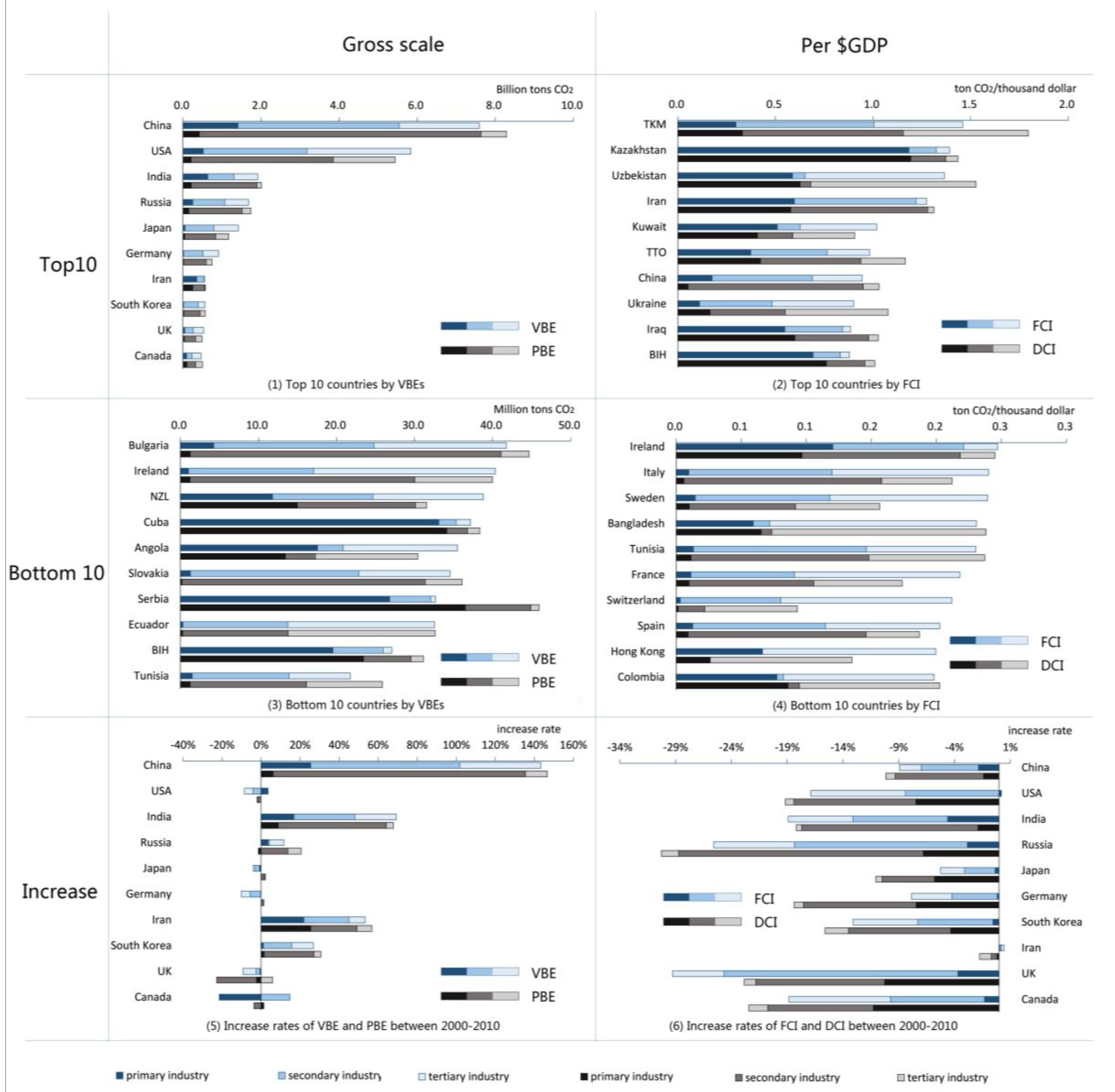
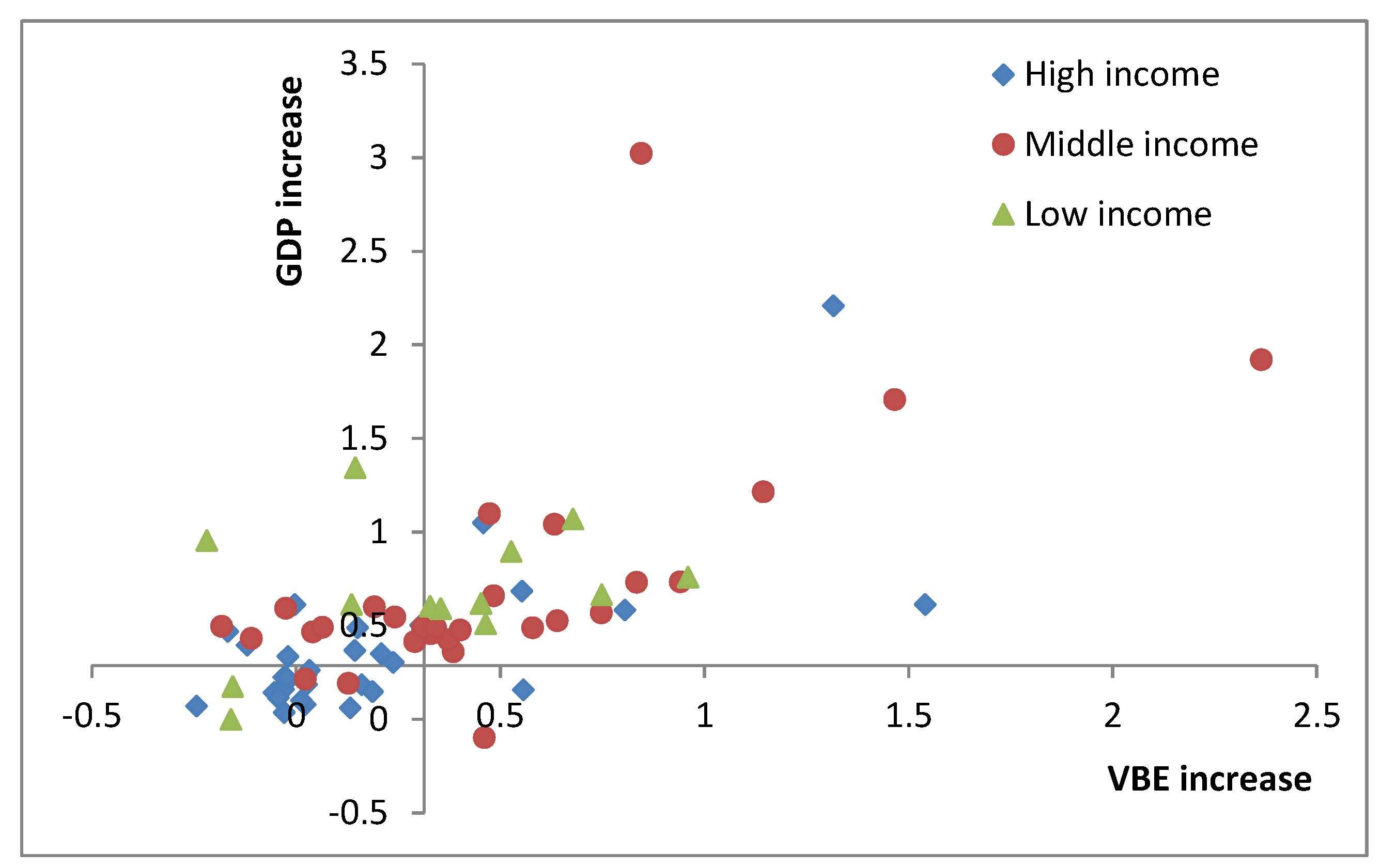
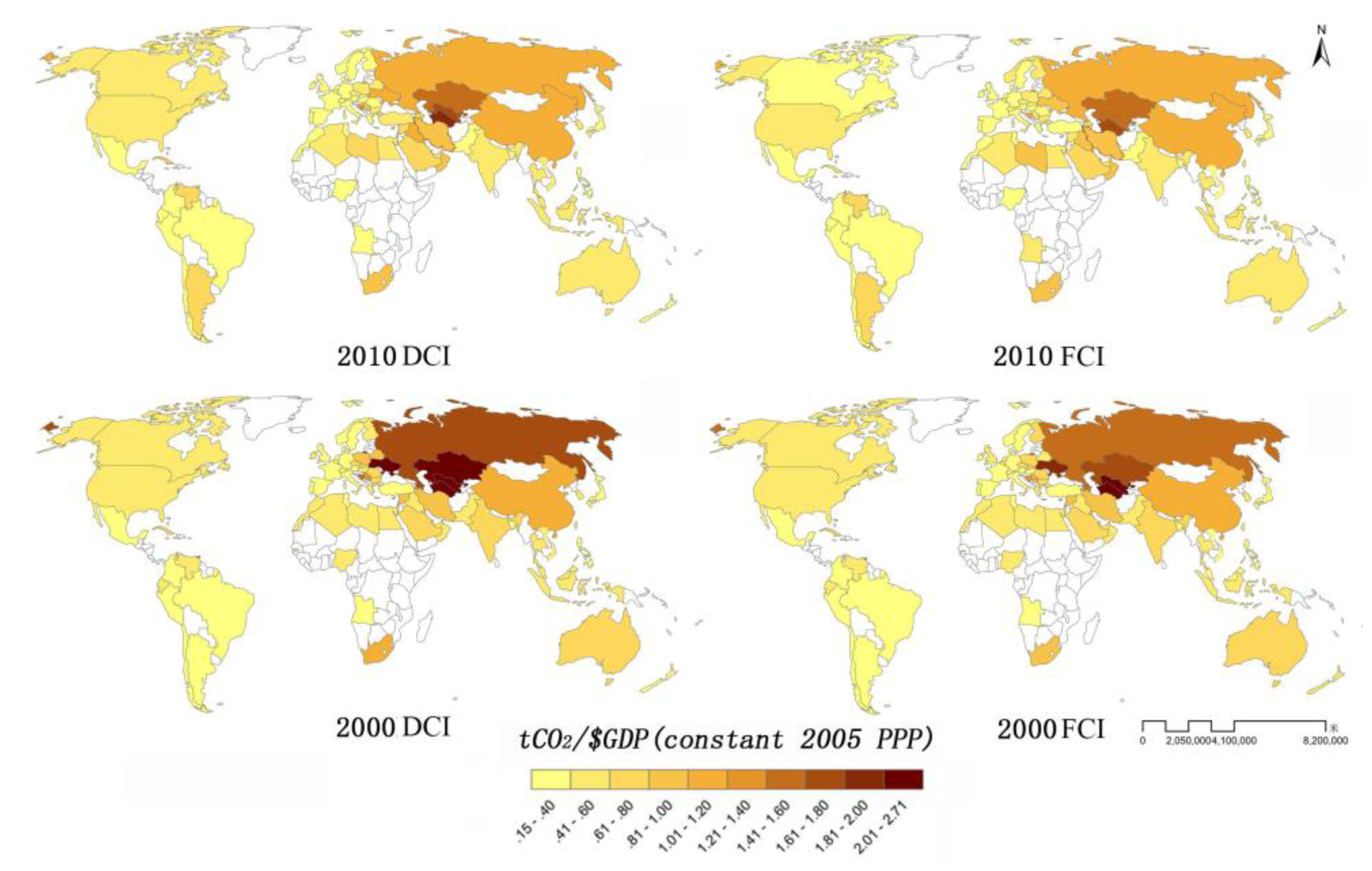
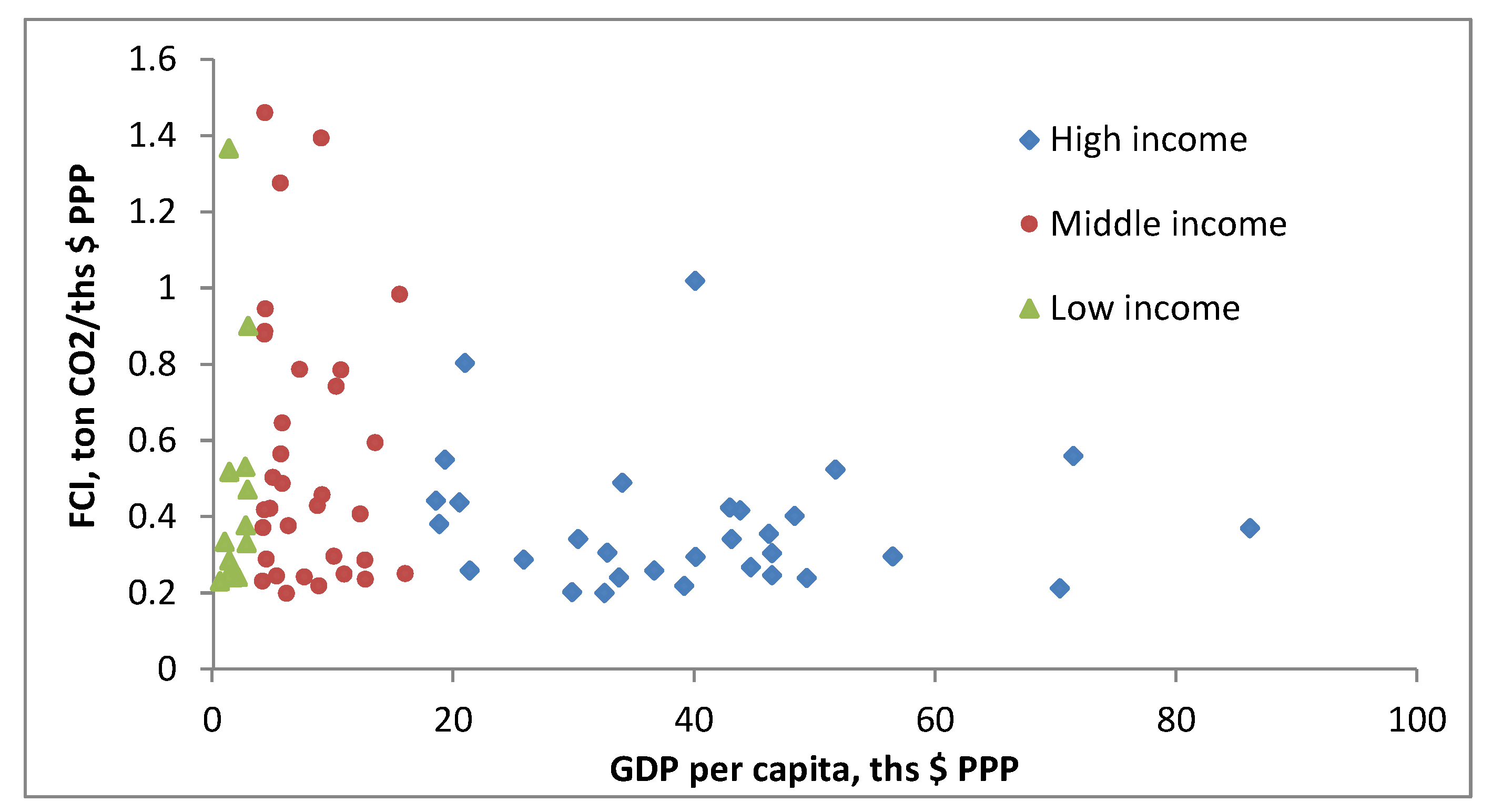
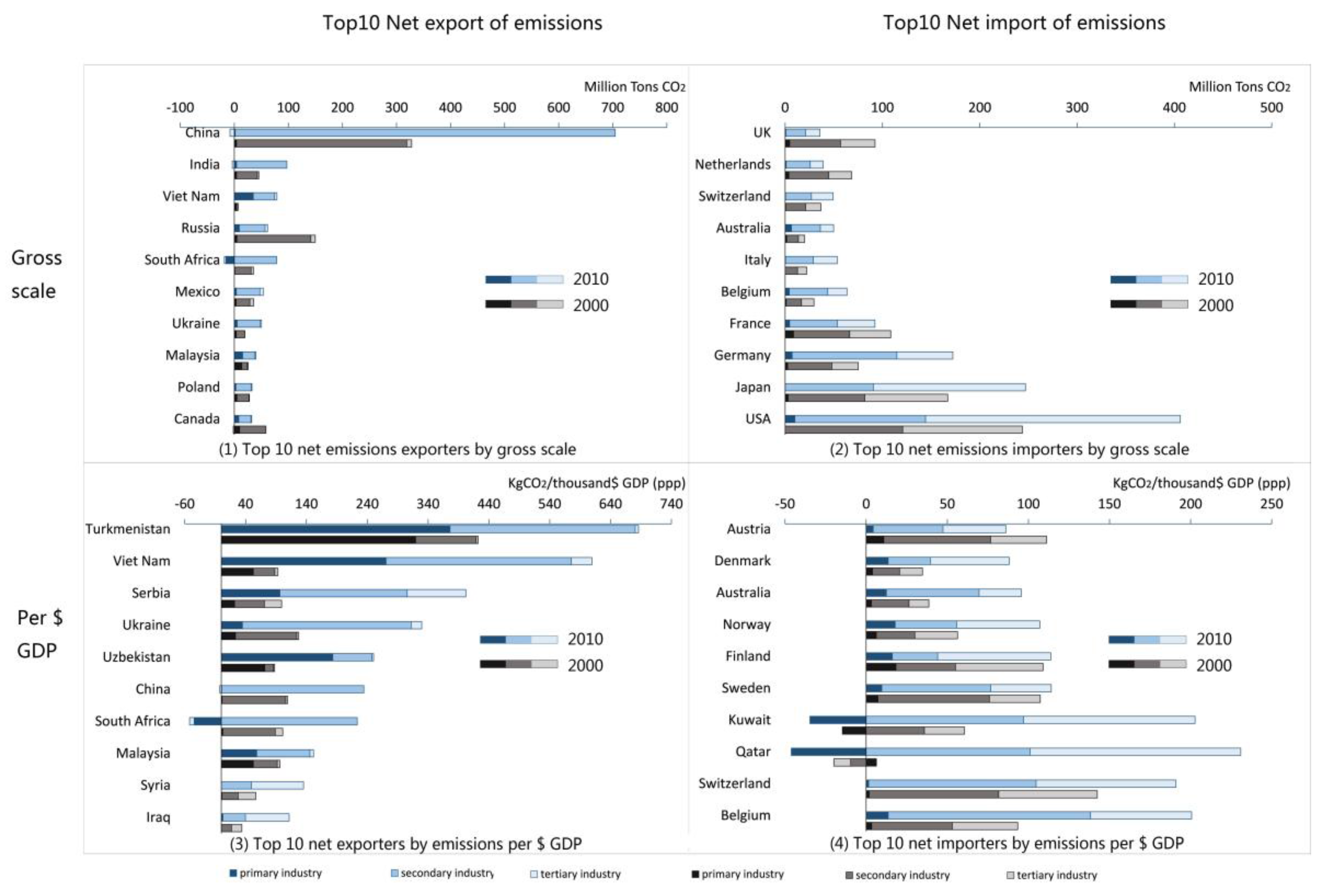

| Intermediate Use | Final Use | Total Output | ||
|---|---|---|---|---|
| Country 1 … Country n | Country 1 … Country n | |||
| Intermediate input | country 1 … country n | trs | frs | tr |
| Value-added | vs | |||
| Total input | ts | |||
| Region | Per Capita | FCI | DCI |
|---|---|---|---|
| GDP/ths Current $ | Ton CO2/ths $ PPP | Ton CO2/ths $ PPP | |
| High income | 38,776 | 0.353 | 0.321 |
| Middle income | 9921 | 0.671 | 0.722 |
| Low income | 3371 | 0.417 | 0.445 |
© 2017 by the authors. Licensee MDPI, Basel, Switzerland. This article is an open access article distributed under the terms and conditions of the Creative Commons Attribution (CC BY) license (http://creativecommons.org/licenses/by/4.0/).
Share and Cite
Liu, H.; Fan, X. Value-Added-Based Accounting of CO2 Emissions: A Multi-Regional Input-Output Approach. Sustainability 2017, 9, 2220. https://doi.org/10.3390/su9122220
Liu H, Fan X. Value-Added-Based Accounting of CO2 Emissions: A Multi-Regional Input-Output Approach. Sustainability. 2017; 9(12):2220. https://doi.org/10.3390/su9122220
Chicago/Turabian StyleLiu, Hongguang, and Xiaomei Fan. 2017. "Value-Added-Based Accounting of CO2 Emissions: A Multi-Regional Input-Output Approach" Sustainability 9, no. 12: 2220. https://doi.org/10.3390/su9122220
APA StyleLiu, H., & Fan, X. (2017). Value-Added-Based Accounting of CO2 Emissions: A Multi-Regional Input-Output Approach. Sustainability, 9(12), 2220. https://doi.org/10.3390/su9122220






